Zenith Trans-Oceanic
G500 Trans-Oceanic
1949-1951
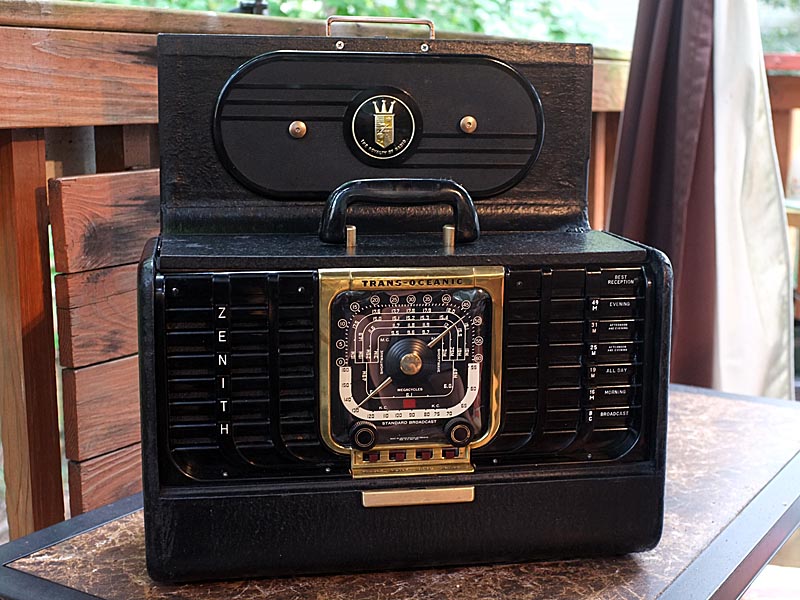 At first glance, the new G500 Trans-Oceanic, introduced in 1949, looks just like the first post-war Trans-Oceanic, the 8G005YT. Cosmetics aside, the G500 was a radically new radio beneath the surface. The all new chassis used five miniature tubes, an 1L6, two 1U4's, an 1S5, and a 3V4. The G500 did not have a rectifier tube; it featured a new solid state selenium rectifier to convert AC to DC.
At first glance, the new G500 Trans-Oceanic, introduced in 1949, looks just like the first post-war Trans-Oceanic, the 8G005YT. Cosmetics aside, the G500 was a radically new radio beneath the surface. The all new chassis used five miniature tubes, an 1L6, two 1U4's, an 1S5, and a 3V4. The G500 did not have a rectifier tube; it featured a new solid state selenium rectifier to convert AC to DC.
The G500 shown here was purchased from Goodwill's online auction site. It was missing the front, the knobs, and the band switch buttons. Goodwill did not list a photo of the inside, but it was obvious from the other photos that the chassis was in the radio. I bid on the radio because I had a spare front left over from my 8G005YT project a few years earlier, and I did not have a G500 yet. I had always wanted one as it is considered by many collectors to be the most beautiful of the Trans-Oceanics, and it is also the rarest, as it was only produced for a short period of time between the 8G005 models and the more modern looking H500.
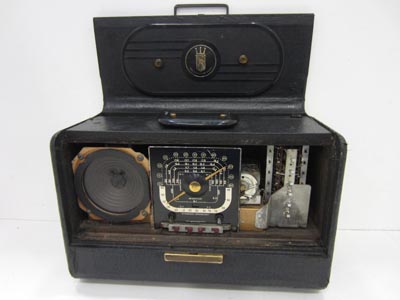 When I received the radio, I was very disappointed to find that the chassis had been badly hacked by someone who should never have been allowed around a vintage radio. Soneone had replaced the electrolytic caps by tacking in new ones under the chassis with no support. They were just hanging, as were two resistors replacing the candohm. When I applied battery power to the chassis it did not work. I was not surprised. At least it had a set of tubes, including the somewhat expensive 1L6. There just happened to be an all original, unrestored G500 chassis on eBay with a Buy-It-Now price of $25.00, but no tubes. When the new chassis arrived, I installed the tubes from the Goodwill chassis and applied power. I was instantly rewarded with good audio and reception on the broadcast band. When an unrestored chassis sounds that good, things can only get better!
When I received the radio, I was very disappointed to find that the chassis had been badly hacked by someone who should never have been allowed around a vintage radio. Soneone had replaced the electrolytic caps by tacking in new ones under the chassis with no support. They were just hanging, as were two resistors replacing the candohm. When I applied battery power to the chassis it did not work. I was not surprised. At least it had a set of tubes, including the somewhat expensive 1L6. There just happened to be an all original, unrestored G500 chassis on eBay with a Buy-It-Now price of $25.00, but no tubes. When the new chassis arrived, I installed the tubes from the Goodwill chassis and applied power. I was instantly rewarded with good audio and reception on the broadcast band. When an unrestored chassis sounds that good, things can only get better!
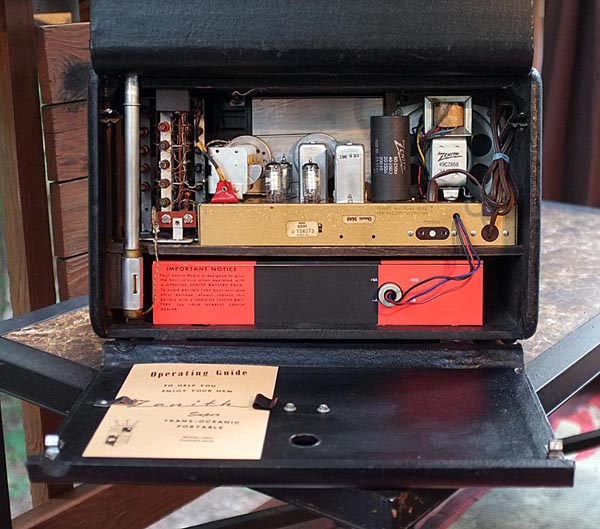 I first replaced the electrolytic capacitors by restuffing the original multicapacitor can. I then tested the radio on AC power, and it did not play. I checked it again on battery power, and it played. I decided to go ahead and replace all the paper/wax capacitors. While recapping the radio, I found a broken wire at the on/off switch. Repairing the broken wire took care of the no AC operation.
I first replaced the electrolytic capacitors by restuffing the original multicapacitor can. I then tested the radio on AC power, and it did not play. I checked it again on battery power, and it played. I decided to go ahead and replace all the paper/wax capacitors. While recapping the radio, I found a broken wire at the on/off switch. Repairing the broken wire took care of the no AC operation.
After the recap, the radio played very well. I checked the resistors in the AC power supply, and the 130 ohm surge resistor following the selenium rectifier was within specificiations, as was the candohm, which is composed of two 950 ohm sections in a single enclosure. Although the 130 ohm surge resistor was within tolerance, I decided to replace it and the selenium rectifier. I replaced the selenium rectifier with a 1N4007 silicon diode rectifier. Since the silicon diode rectifier has much less resistance than the selenim rectifier, it is necessary to add resistance to the circuit to prevent too much voltage from burning out the tube filaments.
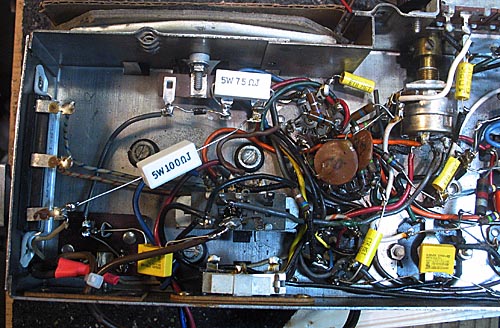 In my experience, a 50 ohm, 5 watt resistor after the silicon diode is about right. Since I didn't have an exact replacement for the 130 ohm surge resistor, I used a 75 ohm, 5 watt resistor after the 1N4007 diode, and a 100 ohm, 5 watt resistor in place of the 130 ohm resistor. This gave me 175 ohms of resistance between the silicon diode and the candohm. This combination provided about 1.34 volts to each of the tube filaments. The tube filaments are designed to operated at 1.4 volts. They will work fine at 1.34, and last a little longer.
In my experience, a 50 ohm, 5 watt resistor after the silicon diode is about right. Since I didn't have an exact replacement for the 130 ohm surge resistor, I used a 75 ohm, 5 watt resistor after the 1N4007 diode, and a 100 ohm, 5 watt resistor in place of the 130 ohm resistor. This gave me 175 ohms of resistance between the silicon diode and the candohm. This combination provided about 1.34 volts to each of the tube filaments. The tube filaments are designed to operated at 1.4 volts. They will work fine at 1.34, and last a little longer.
With the new chassis now working very nicely, it was time to rehabilitate the cabinet. I cleaned the cabinet, and repaired a couple loose pieces of Black Stag covering with Weldwood contact cement. I then polished the cabinet with black shoe polish. I installed a new front from an 8G005 donor radio and a new reproduction dial cover. The knobs came from an 8G005 radio, and the band switch buttons came from two different donors. Most of the cabinet and hardware parts are interchangeable between the 8G005 and G500 models.
With the case restored, I added a reproduction Zenith Z-985 battery and a reproduction owner's manual to complete the restoration. The radio plays very well. The audio quality is good, with plenty of output power, and the sensitivity is good on all bands.
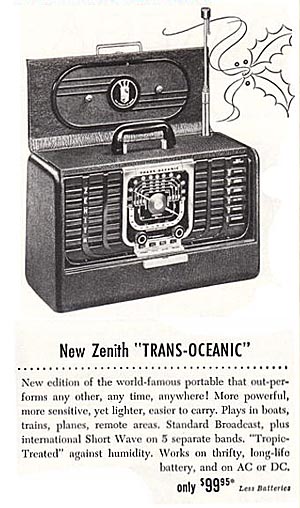
Download a free Restoration Guide for 500 and 600 series Trans-Oceanic radios



 When I received the radio, I was very disappointed to find that the chassis had been badly hacked by someone who should never have been allowed around a vintage radio. Soneone had replaced the electrolytic caps by tacking in new ones under the chassis with no support. They were just hanging, as were two resistors replacing the candohm. When I applied battery power to the chassis it did not work. I was not surprised. At least it had a set of tubes, including the somewhat expensive 1L6. There just happened to be an all original, unrestored G500 chassis on eBay with a Buy-It-Now price of $25.00, but no tubes. When the new chassis arrived, I installed the tubes from the Goodwill chassis and applied power. I was instantly rewarded with good audio and reception on the broadcast band. When an unrestored chassis sounds that good, things can only get better!
When I received the radio, I was very disappointed to find that the chassis had been badly hacked by someone who should never have been allowed around a vintage radio. Soneone had replaced the electrolytic caps by tacking in new ones under the chassis with no support. They were just hanging, as were two resistors replacing the candohm. When I applied battery power to the chassis it did not work. I was not surprised. At least it had a set of tubes, including the somewhat expensive 1L6. There just happened to be an all original, unrestored G500 chassis on eBay with a Buy-It-Now price of $25.00, but no tubes. When the new chassis arrived, I installed the tubes from the Goodwill chassis and applied power. I was instantly rewarded with good audio and reception on the broadcast band. When an unrestored chassis sounds that good, things can only get better! At first glance, the new G500 Trans-Oceanic, introduced in 1949, looks just like the first post-war Trans-Oceanic, the 8G005YT. Cosmetics aside, the G500 was a radically new radio beneath the surface. The all new chassis used five miniature tubes, an 1L6, two 1U4's, an 1S5, and a 3V4. The G500 did not have a rectifier tube; it featured a new solid state selenium rectifier to convert AC to DC.
At first glance, the new G500 Trans-Oceanic, introduced in 1949, looks just like the first post-war Trans-Oceanic, the 8G005YT. Cosmetics aside, the G500 was a radically new radio beneath the surface. The all new chassis used five miniature tubes, an 1L6, two 1U4's, an 1S5, and a 3V4. The G500 did not have a rectifier tube; it featured a new solid state selenium rectifier to convert AC to DC. I first replaced the electrolytic capacitors by restuffing the original multicapacitor can. I then tested the radio on AC power, and it did not play. I checked it again on battery power, and it played. I decided to go ahead and replace all the paper/wax capacitors. While recapping the radio, I found a broken wire at the on/off switch. Repairing the broken wire took care of the no AC operation.
I first replaced the electrolytic capacitors by restuffing the original multicapacitor can. I then tested the radio on AC power, and it did not play. I checked it again on battery power, and it played. I decided to go ahead and replace all the paper/wax capacitors. While recapping the radio, I found a broken wire at the on/off switch. Repairing the broken wire took care of the no AC operation. In my experience, a 50 ohm, 5 watt resistor after the silicon diode is about right. Since I didn't have an exact replacement for the 130 ohm surge resistor, I used a 75 ohm, 5 watt resistor after the 1N4007 diode, and a 100 ohm, 5 watt resistor in place of the 130 ohm resistor. This gave me 175 ohms of resistance between the silicon diode and the candohm. This combination provided about 1.34 volts to each of the tube filaments. The tube filaments are designed to operated at 1.4 volts. They will work fine at 1.34, and last a little longer.
In my experience, a 50 ohm, 5 watt resistor after the silicon diode is about right. Since I didn't have an exact replacement for the 130 ohm surge resistor, I used a 75 ohm, 5 watt resistor after the 1N4007 diode, and a 100 ohm, 5 watt resistor in place of the 130 ohm resistor. This gave me 175 ohms of resistance between the silicon diode and the candohm. This combination provided about 1.34 volts to each of the tube filaments. The tube filaments are designed to operated at 1.4 volts. They will work fine at 1.34, and last a little longer.